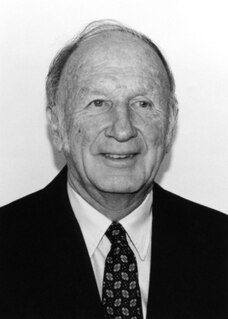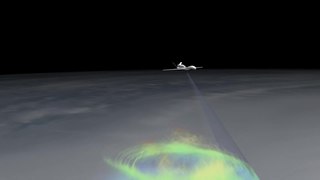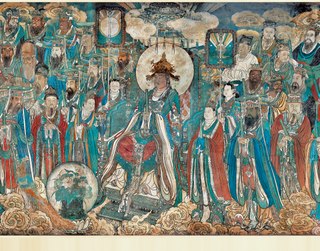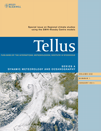
Meteorology is a branch of the atmospheric sciences with a major focus on weather forecasting. The study of meteorology dates back millennia, though significant progress in meteorology did not begin until the 18th century. The 19th century saw modest progress in the field after weather observation networks were formed across broad regions. Prior attempts at prediction of weather depended on historical data. It was not until after the elucidation of the laws of physics, and more particularly in the latter half of the 20th century the development of the computer that significant breakthroughs in weather forecasting were achieved. An important branch of weather forecasting is marine weather forecasting as it relates to maritime and coastal safety, in which weather effects also include atmospheric interactions with large bodies of water.

In ancient Roman religion, Ceres was a goddess of agriculture, grain crops, fertility and motherly relationships. She was originally the central deity in Rome's so-called plebeian or Aventine Triad, then was paired with her daughter Proserpina in what Romans described as "the Greek rites of Ceres". Her seven-day April festival of Cerealia included the popular Ludi Ceriales. She was also honoured in the May lustratio of the fields at the Ambarvalia festival, at harvest-time, and during Roman marriages and funeral rites. She is usually depicted as a mature woman.
Terra may often refer to:

In ancient Roman religion and mythology, Tellus Mater or Terra Mater is the personification of the Earth. Although Tellus and Terra are hardly distinguishable during the Imperial era, Tellus was the name of the original earth goddess in the religious practices of the Republic or earlier. The scholar Varro (1st century BC) lists Tellus as one of the di selecti, the twenty principal gods of Rome, and one of the twelve agricultural deities. She is regularly associated with Ceres in rituals pertaining to the earth and agricultural fertility.

Edward Norton Lorenz was an American mathematician and meteorologist who established the theoretical basis of weather and climate predictability, as well as the basis for computer-aided atmospheric physics and meteorology. He is best known as the founder of modern chaos theory, a branch of mathematics focusing on the behavior of dynamical systems that are highly sensitive to initial conditions.

A hot tower is a tropical cumulonimbus cloud that reaches out of the lowest layer of the atmosphere, the troposphere, and into the stratosphere. These formations are called "hot" because of the large amount of latent heat released as water vapor condenses into liquid and freezes into ice within the cloud. Hot towers in regions of sufficient vorticity may acquire rotating updrafts; these are known as vortical hot towers In some instances, hot towers appear to develop characteristics of a supercell, with deep and persistent rotation present in the updraft. The role of hot towers in tropical weather was first formulated by Joanne Simpson in 1958. Hot towers dominated discussions in tropical meteorology in the 1960s and are now considered the main drivers of rising air within tropical cyclones and a major component of the Hadley circulation. Although the prevalence of hot towers in scientific literature decreased in the 1970s, hot towers remain an active area of research. The presence of hot towers in tropical cyclones is correlated with an increase in the tropical cyclones's intensities.

The Bulletin of the American Meteorological Society is a scientific journal published by the American Meteorological Society. BAMS is the flagship magazine of AMS and publishes peer reviewed articles of interest and significance for the weather, water, and climate community as well as news, editorials, and reviews for AMS members. BAMS articles are fully open access; AMS members can also access the digital version which replicates the print issuecover-to-cover and often includes enhanced articles with audio and video.

The National Observatory of Athens is a research institute in Athens, Greece. Founded in 1842, it is the oldest research foundation in Greece, as it was the first scientific research institute built after Greece became independent in 1829, and one of the oldest research institutes in Southern Europe.

An Earth goddess is a deification of the Earth. Earth goddesses are often associated with the "chthonic" deities of the underworld.

Launched from the Lower East Side, Manhattan in 1983 as a subscription only bimonthly publication, the Tellus Audio Cassette Magazine utilized the audio cassette medium to distribute no wave downtown music and audio art and was in activity for the ten years of 1983–1993.

Tellus Series A: Dynamic Meteorology and Oceanography is a peer-reviewed scientific journal that is published by Co-action Publishing on behalf of the International Meteorological Institute in Stockholm, Sweden. Since January 2012, the journal is published open access. Until that time it had been published as a subscription journal by Blackwell Munksgaard. The journal publishes original articles, short contributions and correspondence encompassing dynamic meteorology, climatology and oceanography, including numerical modelling, synoptic meteorology, weather forecasting, and climate analysis.

Tellus Series B: Chemical and Physical Meteorology is a scientific journal that was published by Blackwell Publishing for the International Meteorological Institute in Stockholm, Sweden until December 2011. From January 2012 the issues are published online by Co-action Publishing as an open access journal. The journal publishes original articles, short contributions, and correspondence on atmospheric chemistry, surface exchange processes, long-range and global transport, aerosol science, and cloud physics including related radiation transfer. Biogeochemical cycles including related aspects of marine chemistry and geochemistry also represent a central theme.

The Mother of the Lares has been identified with any of several minor Roman deities. She appears twice in the records of the Arval Brethren as Mater Larum, elsewhere as Mania and Larunda. Ovid calls her Lara, Muta and Tacita.

Velificatio is a stylistic device used in ancient Roman art to frame a deity by means of a billowing garment. It represents "vigorous movement," an epiphany, or "the vault of heaven," often appearing with celestial, weather, or sea deities. It is characteristic of the iconography of the Aurae, the Breezes personified, and one of the elements which distinguish representations of Luna, the Roman goddess of the Moon, alluding to her astral course.
Pancheti Koteswaram was an Indian meteorologist, hydrologist, atmospheric physicist and the Director-General of Observatories of Government of India. He was a Professor at University of Chicago, University of Hawaii, University of Miami and Tehran University and served as a research associate at National Hurricane Research Laboratory, Miami, and the National Centre for Atmospheric Research, Colorado. A former vice-president of World Meteorological Organization (WMO), Geneva, he was an elected Fellow of the Indian Academy of Sciences, Indian National Science Academy and the Andhra Pradesh Academy of Sciences. The Government of India awarded him the third highest civilian honour of the Padma Bhushan, in 1975, for his contributions to science.











